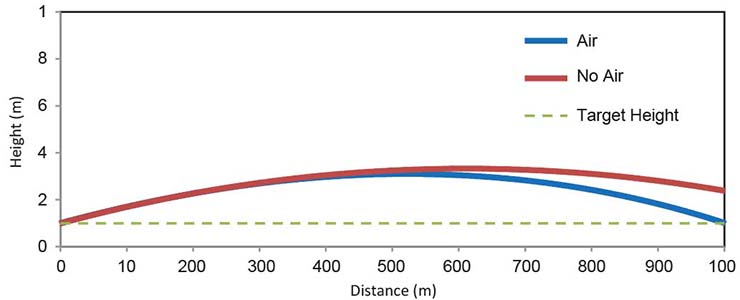Close range shooting doesn’t require a deep understanding of external ballistics. However, when it comes to those longer shots, external factors such as altitude and barometric pressure need to be accounted for. Otherwise a miss is almost guaranteed.
When a bullet leaves the barrel, it must push aside millions of air molecules on its way to the target. Each molecule the bullet hits robs it of a tiny fraction of energy, and the bullet slows. If the air is thin, with fewer molecules occupying a specific volume of space, the bullet does not experience as much drag. This shortens its time of flight, and gravity does not have as much time to pull it downward. Our shot now goes higher than it would if the air was dense.
That’s why in long-range shooting it’s important to have an understanding of how weather changes will influence your trajectories as you travel to different areas of the country.
Temperature and Altitude are related in that they both affect air density and therefore the ballistic performance of a bullet. Lower altitudes and lower temperatures result in denser air. Conversely, higher altitudes and higher temperatures result in thinner air, resulting in less drag on the bullet and less bullet drop. When bullet manufacturers test their bullets, they use a common industry standard – Sea level; 78% humidity, 15 degrees Celsius, and Barometric Pressure of 29.92.
When it comes to long range shooting, altitude and barometric pressure work together. But how do they affect ballistics?

The following graphs will quantify the above to you.


The bullet launched at an angle of 0.436 degrees above the horizontal travels a little over two meters vertically and remains in flight for 1.305 seconds before striking the target. Without air resistance the rifle must be aimed 0.357 degrees above the horizontal to hit the center of the target and the bullet remains airborne for seconds, travelling meters vertically. Clearly air resistance should be considered for measuring a bullet flight, otherwise the target will be missed.
Let’s take another example of an 800 meter shot to demonstrate this further. If you were to move your firing point to an alternate location that sits 1,000 meters (3,300 feet) higher in altitude, you can expect your bullet to impact around 50cm (or 20-inches) above your point of aim. Add in a 5°C increase in temperature and you’re looking at a miss of up to 70cm (or 28-inches). As seen in the following image, this would be complete miss at a man-sized target when aiming at the centre of mass. So what should one do ?
The solution is to re-calculate your trajectory based on current atmospheric conditions during the time of shooting, and continuously update these as and when required.

How Much Does Altitude Really Affect a Bullet?
At closer distances, the point-of-impact shifting due to a change in altitude may be negligible. At 100 meters for example, it is almost non-existent. However, as the distance increases, so will the effect on the bullet’s trajectory. The following table will demonstrate these effects.

We can clearly see that as altitude climbs and the air gets thinner, the bullet’s trajectory gets flatter. It is also evident that the rifle’s effective range also increases with altitude.
The above bullet shot from the same rifle travels an extra 250 meters (up to 1175 meters) when fired at an altitude of 2000 meters (800hPa) as opposed to sea-level.
We can also notice that at 300 meters, the difference in bullet drop is almost negligible; a couple of centimeters at most. This is why seasoned hunters may not even be aware of this altitude influence; since they do not need to account for it to hit their target. But for long range precision shooting, this is vital.
-The writer is the Managing Director of Hughes Precision Manufacturing Pvt. Ltd., India’s first small calibre manufacturer in the private sector.








